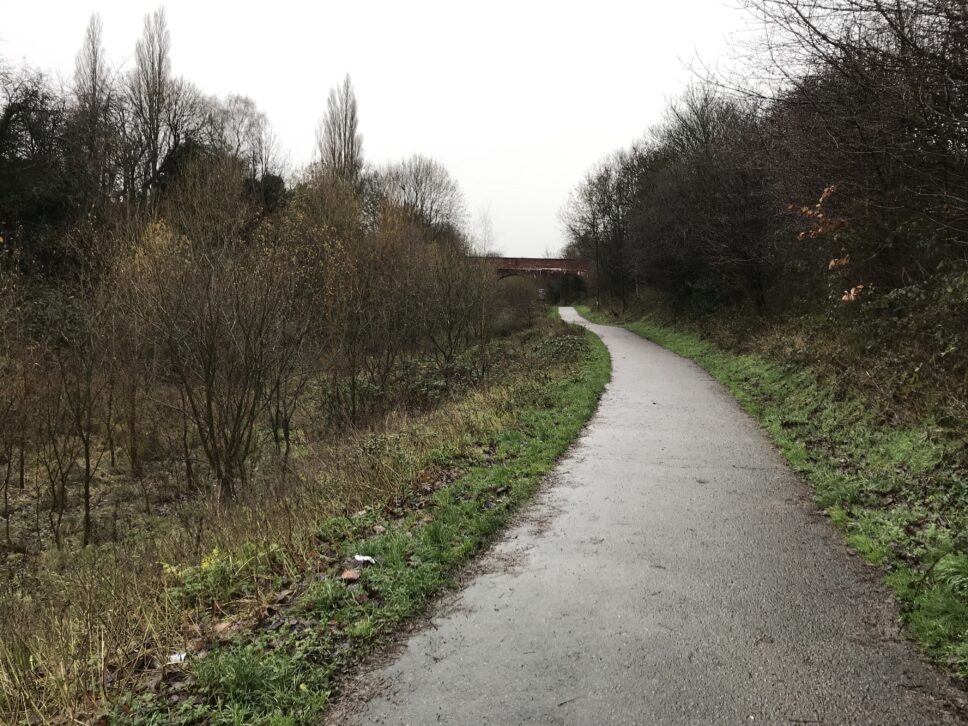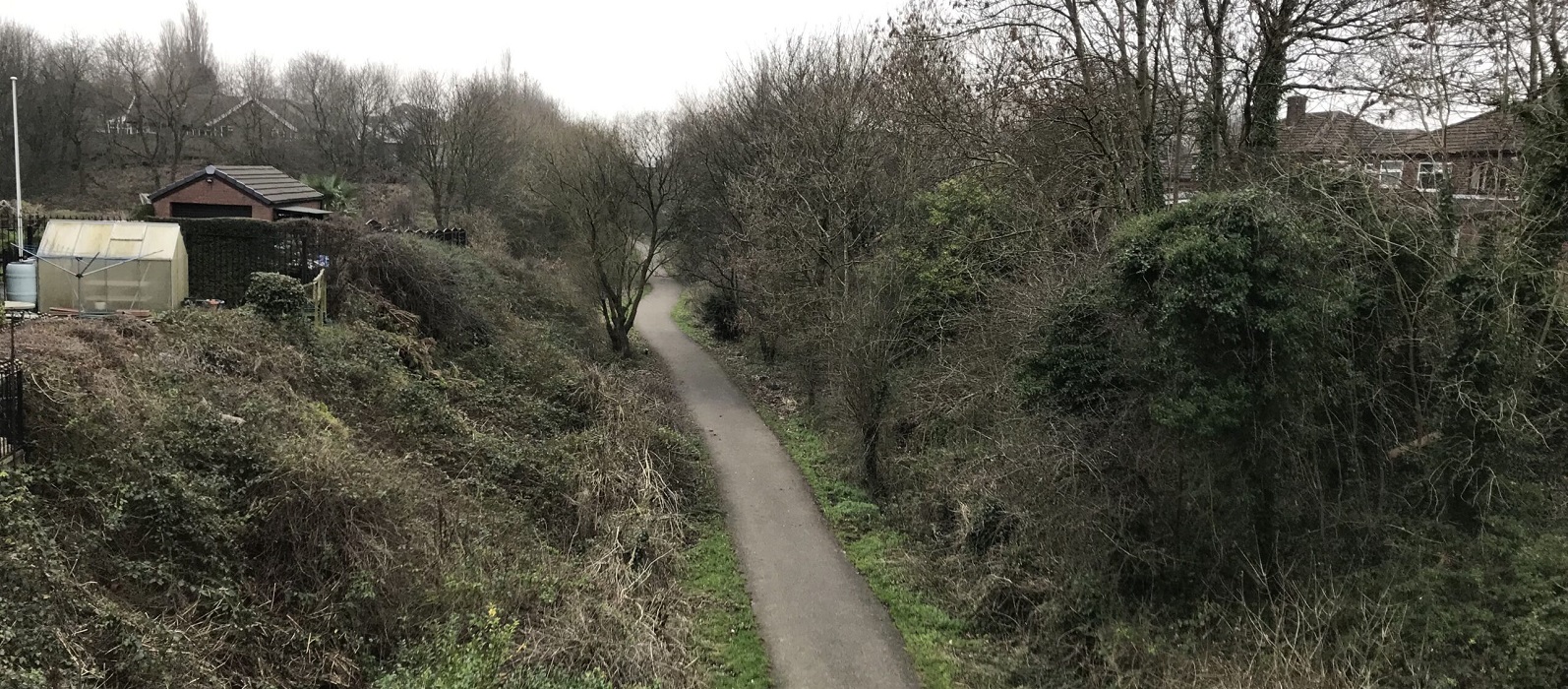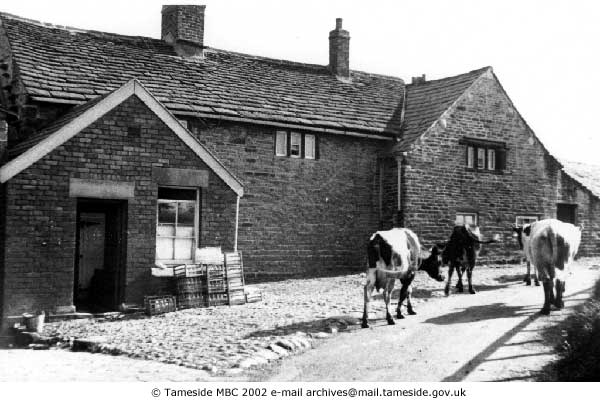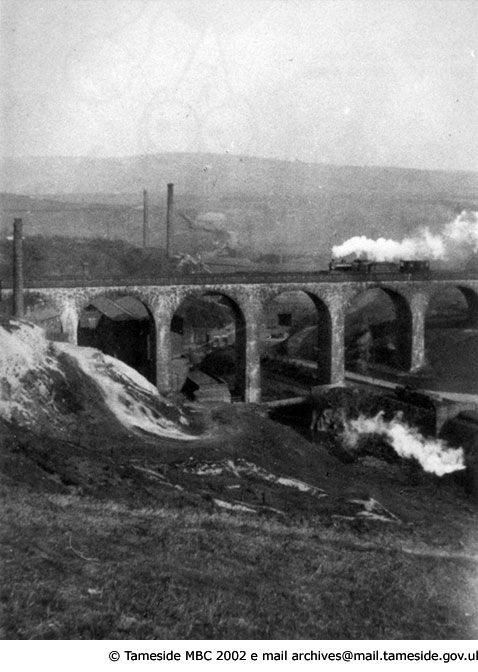Walking in Ashton-under-Lyne, Branch Line

Not far from my home and of course, Besseges (Valves, Tubes and Fittings) Ltd is one of the best ways of enjoying walking in Ashton under Lyne. In days gone by there was once a railway track that ran from Ashton under Lyne to Oldham; via Park Bridge Iron and Steel Works. This particular Branch line serviced Oldham Road Railway Station on the Oldham, Ashton and Guide Bridge Railway. The Line ran from London Road Manchester (Piccadilly) via Guide Bridge to Clegg Street Oldham. The line was fully open in 1861 and even serviced Ashton Moss railway Station which closed a year later in 1862.
This railway branch line was open to passengers till 1959 and closed completely in 1967 as a goods line. I had a conversation with a local man several years ago and he told me how as a child in the 1950s he stood on the exit to the tunnel on Turner Lane. He and his friends used to drop the class pop bottles into the steam locomotive chimney and watch them blast back out with a bang. I am certain that this would have been frowned upon then and be viewed as a criminal now, but am also certain that it was done in complete innocence.
Walking in Ashton under Lyne Meandering
For many years this old railway line remained derelict, it then became a public footpath and cycle track. Probably in response to the opening of the Park Bridge museum in 1975 and further investment to make it a heritage centre in the 1980s. The walk we are about to do is a walk through history dating back to the 17th Century and the beginnings of the Industrial Revolution. This once scar on the landscape has returned to nature; with its stone and brick bridges as much a part of the natural surroundings as the trees.
The start of our walk begins at the gate adjacent to the tunnel at the top of Turner Lane Ashton under Lyne. This walk can be done alone with your thoughts, your faithful dog or with as many people as you choose. Step through the gate and ahead is a sloped track heading towards the first bridge on this journey. For five years I had walked our two dogs Brodie and Charlie along this track twice a day.
Although I have no belief in an omnipotent all-seeing being and its trappings, my hope is they still walk the track with us now. Invisible to my eyes but still enjoying the safety afforded by this walk away from roads and traffic. I am sure the memories of many people still walk this way every day as they would have done throughout their lives. Places like this where so many have passed the time will give solace to those they have left behind; a hope that they still walk in Ashton under Lyne alongside them as they continue on the path.
This walk for us, is again done twice a day with our dog Gelert, who by strange coincidence has developed traits associated with the dogs no longer with us. His personality could be seen as a joint effort of the two dogs we had lost over the last two years. Even though he had no real connection to them other than the people who love and care for him. If you walk this shared amenity, dog walking has become a central part of the track but by no means the whole story.
Walking in Ashton under Lyne Bridges and Mining
We were meandering a little there from the story I am trying to tell about this relatively tranquil piece of Ashton under Lyne. The track begins with a slope to a stone road bridge ahead in the near distance, with another entrance from the left-hand side. If you look below to the left-hand side the path of the old railway line emerges from a short tunnel that once ran from Oldham Road Railway Station. This wild area of trees and marsh ground is generally untouched, other than by the odd wandering dog and the occasional wildlife.

As you look ahead it is easy to see the line of the old railway as it approached the arches of the bridge ahead. It’s not difficult to imagine the sight, sound and smell of a steam locomotive building speed as it passed by. Just beyond the three arches of the bridge ahead is a brick structure still visible amongst the brambles and undergrowth.
This I believe is the site of the coal loading area for Lordsfield Colliery which commenced in 1856 and closed nineteen years later in 1875. The main shaft to what was known as the Great Mine was at a depth of around 342m. The Miners hit a spring while digging the original shaft with a water flow of between 64000 and 82000 litres an hour. 200 Horse Power Engines were locally sourced to pump out the water, so the coal seam could be worked. The shaft was increased by another 27m to reach another coal seam known as the Roger Mine.
Lordsfield is still part of Ashton under Lyne with many of the houses that were built there being owned by New Charter Housing. It is amazing to realise that this entire estate is built on the slag heaps and mine workings from more than a century ago. Continuing on our journey from this point the path heads towards the second bridge spanning the track, this bridge is now only a footbridge. In the middle of the 19th century this bridge crossed to Smallshaw Fold from what is now Waterloo Road.
Walking in Ashton under Lyne Grafitti and Stories
Before we pass under this 160-year-old stone arch, we approach a fork in the path leading off the track to a field and head towards the third bridge. This road bridge has been recently refurbished and brought up to date, but its new white walls are not in keeping with its surroundings. Sadly the less intelligent of our local youth feel it necessary to spoil it with graffiti they often can’t even spell correctly. But once we pass this point it looks and feels like you are stepping out of industrial Ashton under Lyne.
For the next mile, the countryside that is so close to Ashton becomes more apparent, despite the fact you can see plenty of suburban housing; left and right. As you walk onto the horse trough in the distance you will pass by hidden valleys with streams and the treasures of nature. You are only minutes away from the main roads and the bustle of modern life. As we leave the overhanging canopy of trees, fields come into view on both sides. Once upon a time, these were the home of local Dairy Herds which can still be seen occasionally.

More recently wild deer have been seen in this area as the land is being reclaimed by the natural world. To my Grandchildren, this is also an area where myths come to life, a place of stories where fairies, elves and pixies live; or even where a Troll lives under a bridge. As you explore this however you choose to, don’t forget to use your imagination as well as your eyes. Where children are present, magic can live anywhere and everywhere; just because they can’t see the fairy doesn’t mean it can’t be there for them.
Continuing our journey along the track brings you to two five-bar gates on both sides, a point where cattle cross from one field to another. The gate to the left has a right of way that can shorten the route to Daisy Nook Country Park; the gate on the right leads to what I believe is private pasture land. Moving passed these two gates the path moves on and starts the slope down to Alt Hill Lane.
Walking in Ashton under Lyne Structures Lost to History
At the time this railway was in operation the slope down to Alt Hill Lane did not exist, what was here was in the days gone by a bridge crossing the lane. This like many monuments to the age of steam approaching Park Bridge that are no longer here. At this point in walking in Ashton under Lyne, we cross the first road; don’t be fooled by this quiet-looking lane as it can be busy. It is designated a quiet area, but you still get the occasional bad driver who spoils the peace with too much engine noise.
 Across the road is the next section of the walk which takes you to Park Bridge and across Alt Hill Road, which is little more than a farm track at this point. Not a road for your average car, more horses or four-wheel drive vehicles. Once you have crossed this final road, what I believe is now in front of you is what was the old tramway; that predates the railway line. The railway line that continued across from Park Bridge Railway Station, was carried by a viaduct which had around ten arches.
Across the road is the next section of the walk which takes you to Park Bridge and across Alt Hill Road, which is little more than a farm track at this point. Not a road for your average car, more horses or four-wheel drive vehicles. Once you have crossed this final road, what I believe is now in front of you is what was the old tramway; that predates the railway line. The railway line that continued across from Park Bridge Railway Station, was carried by a viaduct which had around ten arches.
This long-gone structure carried goods to Clegg St Railway Station and Goods yard in Oldham until 1967. This piece of Victorian engineering that dwarfed its surroundings is lost to history and the image probably doesn’t do it justice. The great iron and steel works it served is also lost to the past; but if you visit Paris and the Eiffel Tower. The rivets that hold this great structure together were manufactured here in Ashton under Lyne.
Walking in Ashton under Lyne The Post Office and Beyond
Park Bridge Iron and Steel Works was owned by the Lees Family with one of its most famous leaders being Hannah Lees. Her guile and appetite for forwarding the business owned and previously run by her husband made it a world leader in the production of ironware. By following the path and letting it guide you around a left-hand bend and across a river bridge. You enter the vast area that was Park Bridge Iron and Steel Works.
If you have the time, it is worth exploring the many building sites that will give you an idea of the scale of manufacturing that took place here for nearly two centuries. The first recorded metal working at Park Bridge was as early as 1786 when Samuel Lees opened the first factory here. On his death in 1804, the previously mentioned Hannah Lees took over from her husband.
The only question mark against the Lees family was their religious following. They were one of the leading Ashton under Lyne families that financed John Wroe’s Church of the Christian Israelites, even building a replica of Solomon’s Temple in the town. At the time all the leading Ashton families paraded through the streets once a year wearing only white garb. I know that this is digressing from walking in Ashton-under-Lyne, but history is what makes a place, and sometimes it is right in front of you.
Once you have crossed the river bridge and followed the path to the top of the nearest slope. A big part of the local industrial revolution and its beginnings are in front of you. There are many options now to extend the walk or just return the way you have come. By following the path with the river to your left you will come to what was Park Bridge Post Office. Keeping the Post Office building to your right the lane rises in ahead of you.
Walk up the lane and follow it to the right-hand side and when you reach the top of the incline, the largest part of what is left of these works is to your right. A cobbled road stretches out, leading you towards the various walks available to the public in this area. Continuing walking in Ashton under Lyne and following the cobbled road, will return you to Alt Hill Lane which eventually leads to Oldham Road.
Further exploration of this area can carry walkers to what was the banks of the Fairbottom Branch Canal. Follow this to Bardsley Bridge under Oldham Road Ashton under Lyne and Daisy Nook is an area of natural beauty; with walking, cycling and bridle paths to follow. Mining subsidence did eventually damage this branch of the local canal system; resulting in its closure in 1932. A large section of this waterway is now a bridle path, we can only hope that in these days of reopening historical waterways, this one may yet see traffic again.
If though you have now had a long enough walk in Ashton-under-Lyne, the old railway track walk is accessible from Alt Hill Lane. Returning down the track will of course bring you back to the beginning of the walk. If you happen to be coming back this way on a warm early summer’s evening as the light begins to fade. Look out for the Bats that inhabit the trees above you; sometimes flying so close that you feel their breeze across the top of your head.
Walking in Ashton under Lyne Discover its History
Walking in Ashton under Lyne can be a pleasant surprise, as you look towards the distant Pennines. You would think that a good walk in the countryside is a long way away from this northern town and you would be wrong. Ashton although a pretty non-descript place in the industrial Northwest has hidden history and places to explore that would surprise many.
Its lost past can be found by looking more carefully under the surface with its industrial heritage hiding a place; that was once referred to as Northern Jerusalem. Here is a challenge for you, come and try walking in Ashton under Lyne and discover its four gates. The replica of Solomon’s Temple was built not far from the local Parish Church which has stood since 1262. Walking in Ashton under Lyne is something to consider whether it is history or walking you love; it has much to offer everyone.
Thank you as always to the Tameside Image Archive for their valuable assistance in providing images for this blog on walking in Ashton-under-Lyne.
Register For An Account
Save & manage your details, access invoices, and enjoy a quicker shopping experience!